one for the gurus, i'm a little confused, as usual...
Discussion
whilst re-reading a book on chassis setup/suspension today I think I got myself confused, yet again.
If the CoG is above the front moment centre and the vehicle turns into a left hand bend the moment centre moves to the right, making the chassis roll clockwise (lookin from behind) along the axis of force/gravity.
That bit I can understand and is simple physics to me. where I confused myself was (probably overthinking made it worse):
if the CoG is BELOW the front moment centre and the vehicle then makes the same turn left on exactly the same corner and path, the moment centre moves to the left but how does this affect chassis roll? will the chassis roll anti-clockwise? and would this be a good or bad thing for a track setup?
i'm pretty sure i've thought about it the wrong way but I coould be correct, :lol:
If the CoG is above the front moment centre and the vehicle turns into a left hand bend the moment centre moves to the right, making the chassis roll clockwise (lookin from behind) along the axis of force/gravity.
That bit I can understand and is simple physics to me. where I confused myself was (probably overthinking made it worse):
if the CoG is BELOW the front moment centre and the vehicle then makes the same turn left on exactly the same corner and path, the moment centre moves to the left but how does this affect chassis roll? will the chassis roll anti-clockwise? and would this be a good or bad thing for a track setup?
i'm pretty sure i've thought about it the wrong way but I coould be correct, :lol:
You need to learn to think in terms of roll axis, rather than front moment centre (geometric roll centre): a car has two ends and they don't roll independently of one another unless you have a very, very serious chassis stiffness problem. 
That aside...
If the CoG is above the roll axis (normal practice), the car will lean out of the bend.
If the CoG is below the roll axis, the car would lean into the bend. Simples.
In practice, you wouldn't want a CoG below the roll axis, because high roll centres give large jacking moments with independent suspension.
It gets a bit more complicated when you start thinking about the effects of roll axis inclination and spring roll resistance, but the above still holds true.

That aside...
If the CoG is above the roll axis (normal practice), the car will lean out of the bend.
If the CoG is below the roll axis, the car would lean into the bend. Simples.
In practice, you wouldn't want a CoG below the roll axis, because high roll centres give large jacking moments with independent suspension.
It gets a bit more complicated when you start thinking about the effects of roll axis inclination and spring roll resistance, but the above still holds true.
thanks for that ^^
so the way I understand this is that the centre of gravity should always be above the moment centre, but should be as close to it as possible to reduce chassis roll, on a track/race setup. with everything else setup to match.
is there any instance/car that has the CoG below?
so the way I understand this is that the centre of gravity should always be above the moment centre, but should be as close to it as possible to reduce chassis roll, on a track/race setup. with everything else setup to match.
is there any instance/car that has the CoG below?
jimbob82 said:
so the way I understand this is that the centre of gravity should always be above the moment centre, but should be as close to it as possible to reduce chassis roll, on a track/race setup.
More basic than that: the CoG should always be as low as possible to reduce weight transfer.
Forget chassis roll and roll centres: the total weight transfer is a simple function of track width (or wheelbase for longitudinal weight transfer under braking or acceleration), CoG height and cornering (or longitudinal braking/accelerative) force, nothing else
The lower your CoG, the less weight will be transferred and the more evenly the work will be distributed over the contact patches of the four tyres.
You can distribute the total weight transfer diagonally, so that the car 'leans' more onto one outside corner - by means of roll axis inclination, different front:rear spring rates, or anti roll bars, to adjust oversteer/understeer balance, but the total weight transfer will remain the same.
jimbob82 said:
is there any instance/car that has the CoG below?
Some vintage cars with beam axles (where the roll centre is at or close to the middle of the axle, at hub height) have roll centres close to the CoG. I'm not personally aware of any that have the CoG below the roll axis, but it would be easy enough to achieve if you used large enough diameter wheels and an underslung chassis (or a suitable locating linkage like an inverted WOBlink or Mumford link).There have been various tricksy suspension systems that achieve zero roll, or tilt the chassis into the corner, either by geometric means or by 'active' hydraulics, but for various reasons they haven't caught on.
You have to ask yourself why you want to get rid of roll in the first place: one elementary mistake made by many people is to assume that just because a car doesn't roll, there is no weight transfer taking place. This is nonsense - as explained above, total weight transfer has nothing to do with chassis roll.
It's generally accepted that some roll is a good thing, because it allows the driver to judge the build-up of cornering forces better. And tilting suspension systems that 'bank' the car into the bend can cause motion sickness, if you don't get the frequencies right.
The only reason I can think of for wanting a totally 'flat' chassis is to maintain a level aerodynamic platform - which is why ground effect race cars run so stiff in roll and pitch.
As I look at the excessively lowered cars the kids currently favour a geometry issue deep in my ageing memory emerges.
The possibility that the roll center has been pushed below the road surface.
As I understand it, this causes a problem with sideways slip in fast corners, have I got this right?
The possibility that the roll center has been pushed below the road surface.
As I understand it, this causes a problem with sideways slip in fast corners, have I got this right?
PaulKemp said:
As I understand it, this causes a problem with sideways slip in fast corners, have I got this right?
It's complicated, but yes, it can. The 'problem' with below-ground roll centres is simply that whilst (as mentioned above) any roll centre above ground creates a 'jacking' force with independent suspension that tries to lift the sprung mass, so a below-ground roll centre creates a pro-roll, downward leverage on the sprung mass that has to be resisted by stiffer springs or anti-roll bars, which degrade grip.
A further problem with lowered cars is that if the car has different suspension geometries front and rear, you can end up dramatically changing the roll axis inclination, which has a major effect on understeer/oversteer balance (and the steeper the roll axis slopes down toward the front of the car, the more diagonal weight transfer you get onto the front corner, promoting understeer).
Some race cars have successfully used roll centres below ground level, but what does usually cause problems (IMO) is if the roll centre migrates through the ground plane as the suspension moves, because you then end up with a sudden change in the direction of the leverage acting through the suspension members. You will appreciate that forces suddenly changing direction in the middle of a bend is not usually going to generate a happy situation!
Some people claim to be able to manage this through-ground-plane roll centre migration in such a way that it benefits the handling, but I'm not that clever, so I wouldn't try.
TheLastPost said:
...forces suddenly changing direction in the middle of a bend is not usually going to generate a happy situation!
isn't that along the lines of what was wrong with Senna's car? not the fatal one but I remember seeing him in the recent film complaining (quite rightly) about the car sort of doing what it wanted. wanting to spontaneously change direction mid corner...?TheLastPost said:
It's complicated, but yes, it can.
The 'problem' with below-ground roll centres is simply that whilst (as mentioned above) any roll centre above ground creates a 'jacking' force with independent suspension that tries to lift the sprung mass, so a below-ground roll centre creates a pro-roll, downward leverage on the sprung mass that has to be resisted by stiffer springs or anti-roll bars, which degrade grip.
A further problem with lowered cars is that if the car has different suspension geometries front and rear, you can end up dramatically changing the roll axis inclination, which has a major effect on understeer/oversteer balance (and the steeper the roll axis slopes down toward the front of the car, the more diagonal weight transfer you get onto the front corner, promoting understeer).
Some race cars have successfully used roll centres below ground level, but what does usually cause problems (IMO) is if the roll centre migrates through the ground plane as the suspension moves, because you then end up with a sudden change in the direction of the leverage acting through the suspension members. You will appreciate that forces suddenly changing direction in the middle of a bend is not usually going to generate a happy situation!
Some people claim to be able to manage this through-ground-plane roll centre migration in such a way that it benefits the handling, but I'm not that clever, so I wouldn't try.
Jacking, and below ground RCs seem to be misunderstood.The 'problem' with below-ground roll centres is simply that whilst (as mentioned above) any roll centre above ground creates a 'jacking' force with independent suspension that tries to lift the sprung mass, so a below-ground roll centre creates a pro-roll, downward leverage on the sprung mass that has to be resisted by stiffer springs or anti-roll bars, which degrade grip.
A further problem with lowered cars is that if the car has different suspension geometries front and rear, you can end up dramatically changing the roll axis inclination, which has a major effect on understeer/oversteer balance (and the steeper the roll axis slopes down toward the front of the car, the more diagonal weight transfer you get onto the front corner, promoting understeer).
Some race cars have successfully used roll centres below ground level, but what does usually cause problems (IMO) is if the roll centre migrates through the ground plane as the suspension moves, because you then end up with a sudden change in the direction of the leverage acting through the suspension members. You will appreciate that forces suddenly changing direction in the middle of a bend is not usually going to generate a happy situation!
Some people claim to be able to manage this through-ground-plane roll centre migration in such a way that it benefits the handling, but I'm not that clever, so I wouldn't try.
Jacking is simply geometric anti-roll, the lateral version of anti-dive or anti-squat. If the RC is on the ground, there is no anti or pro roll effects, the roll resistance is purely down to the elastic components. If it is below ground, it is pro-roll. Nothing scary happens when you cross that plane in motion, all that happens is that the geometric anti-roll force reduces to zero, then goes negative as the RC heads south. All this means is, if the RC does go south with roll, the rate of roll will increase. It will do that regardless of wether or not the RC crosses the ground plane, and you'll never know the difference if it does or not.
Put simply, it does not matter.
Kozy said:
Nothing scary happens when you cross that plane in motion, all that happens is that the geometric anti-roll force reduces to zero, then goes negative as the RC heads south....
Put simply, it does not matter.
In theory, you're absolutely correct. In theory, as you suggest, you simply get a nice, smooth graph of the force as it reduces to zero then goes negative.Put simply, it does not matter.
In practice...
I usually use the analogy of an over-centre catch to describe the problem of forces changing direction, but perhaps the scenario of toe-in/toe-out might be more relevant and descriptive. You get a 'dead spot' due to tolerances, compliance and play in components as the force reduces to zero, then goes negative, with a consequent unpredictability about the rate of change of the force.
As I'm sure you're aware, the whole point of toe setting is to keep some 'tension' in the system (to always maintain a degree of scrub, be it positive or negative, whatever the steering/suspension movement, to take up slack in the joints and bearings). You would never intentionally design a geometry that moved from toe-in to toe-out through the normal range of suspension loads and movement, as the end result would be something that handled like the proverbial shopping trolley with a wobbly caster.
The issue with RC going through the ground plane is essentially similar - you've got a 'dead spot' around the zero force transition, as the vertical component of the forces being fed through the suspension arms goes from positive to negative.
You also need to bear in mind that, like toe, the transition is usually happening over a fairly small range of movement (I usually try to maintain RC location both sideways and vertically within 5mm of the same position relative to the sprung mass, and with a race car the total movement of the sprung mass relative to the ground plane can be only 50-60mm most of the time), so if you have a design where the RC is moving through the ground plane, the chances are it will be happening at a fairly high frequency.
Best avoided, IMO?
Edited by TheLastPost on Thursday 7th March 19:55
Do the forces not emanate from the COG at either end?
Meaning that for a zero force / 100% anti roll / dead spot on over centre latch situation to occur, you would need the roll centre at the COG, i.e. in line with it and the contact patch, not the ground.
Or am I missing something?
Meaning that for a zero force / 100% anti roll / dead spot on over centre latch situation to occur, you would need the roll centre at the COG, i.e. in line with it and the contact patch, not the ground.
Or am I missing something?
Edited by Mark_r33 on Thursday 14th March 17:34
Disclaimer: I'm typing this after three bottles of wine, so I'll probably wake up in the morning and discover I've been talking even more b ks than usual (it happens a lot...) but:
ks than usual (it happens a lot...) but:

...But the tyre thrust creates a separate jacking force on independent suspensions (either positive or negative, depending whether the RC is above or below ground), which effectively adds a pro- or anti- roll element to the loads on the springs. It's a geometric leverage exerted by tyre thrust against the geometric roll centre, though (ie. the couple of distance between tyre contact patch and the geometric roll centre x tyre cornering force), not weight transfer generated by the couple between CoG height and cornering force.
 ks than usual (it happens a lot...) but:
ks than usual (it happens a lot...) but:Mark_r33 said:
Do the forces not emanate from the COG at either end?
There is only one CoG for the sprung mass. There isn't one at either end. 
Mark_r33 said:
Meaning that for a zero force / 100% anti roll / dead spot on over centre latch situation to occur, you would need the roll centre at the COG
Yes, if the mean roll couple is zero (ie. roll axis and CoG coincide) then all weight is transferred via geometric roll centres and none via the springs, so you get zero roll due to weight transfer....But the tyre thrust creates a separate jacking force on independent suspensions (either positive or negative, depending whether the RC is above or below ground), which effectively adds a pro- or anti- roll element to the loads on the springs. It's a geometric leverage exerted by tyre thrust against the geometric roll centre, though (ie. the couple of distance between tyre contact patch and the geometric roll centre x tyre cornering force), not weight transfer generated by the couple between CoG height and cornering force.
TheLastPost said:
Yes, if the mean roll couple is zero (ie. roll axis and CoG coincide) then all weight is transferred via geometric roll centres and none via the springs, so you get zero roll due to weight transfer.
...But the tyre thrust creates a separate jacking force on independent suspensions (either positive or negative, depending whether the RC is above or below ground), which effectively adds a pro- or anti- roll element to the loads on the springs. It's a geometric leverage exerted by tyre thrust against the geometric roll centre, though (ie. the couple of distance between tyre contact patch and the geometric roll centre x tyre cornering force), not weight transfer generated by the couple between CoG height and cornering force.
Is that not the same thing? The reason it doesn't roll, is because of the 'jacking' (geometric anti-roll) effect?...But the tyre thrust creates a separate jacking force on independent suspensions (either positive or negative, depending whether the RC is above or below ground), which effectively adds a pro- or anti- roll element to the loads on the springs. It's a geometric leverage exerted by tyre thrust against the geometric roll centre, though (ie. the couple of distance between tyre contact patch and the geometric roll centre x tyre cornering force), not weight transfer generated by the couple between CoG height and cornering force.
Kozy said:
Is that not the same thing?
No. The jacking force is a jacking force (ie. it tends to lift - or depress if it's negative - one side of the chassis, not to roll (rotate) it).The only reason we talk about it being 'pro roll' or 'anti roll' is that it can act in the same direction as the roll forces (above ground roll centres), or in the opposite direction (below ground roll centres).
TheLastPost said:
No. The jacking force is a jacking force (ie. it tends to lift - or depress if it's negative - one side of the chassis, not to roll (rotate) it).
But if you lift one side, and depress the other side, that is roll, is it not? Even if you do not depress the other side (liek zero droop) there is still a net roll action?I'm having difficulty separating the two actions.
Kozy said:
I'm having difficulty separating the two actions.
The roll moment is the couple of cornering force (acting on the CoG of the sprung mass) x distance between geometric roll axis and CoG. It can be reacted by any combination of resistance by the springs/ARBs and geometric leverage via the roll centres.The jacking moments are the couples of tyre thrust x distance between tyre contact patch and instantaneous centre. There are four of them, one for each tyre contact patch and each pair in turn creates a couple between the instantaneous centres. It's the neutral axis of this secondary couple that defines the force-based roll centre.
As you suggest, the jacking moments are in opposite directions on either side of the car but, importantly, the tyre thrusts are different on each side (the more heavily loaded outside wheel generating a lot more thrust than the lightly loaded inside wheel), so the difference between them will result in a net vertical force, jacking the car up or down. This is why determination of the Force Based Roll Centre requires a knowledge of the distribution of forces between the car's tyres (which can be very difficult to determine accurately) and why people argue that the Geometric Roll Centre as a concept has limited value.
This is what jacking looks like on paper (as a worked example from Costin & Phipps, based on a swing axle design):
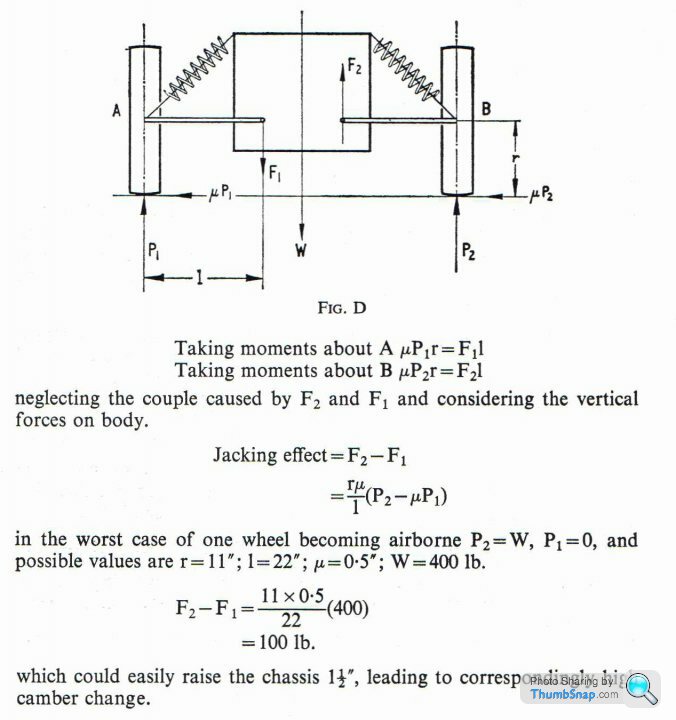
...and this is what it looks like in practice (courtesy of Triumph):
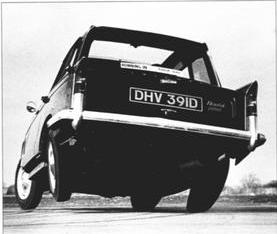
...and this is a diagram illustrating the concept of the Force Based Roll Centre (note the vertical pink arrow denoting net jacking force):
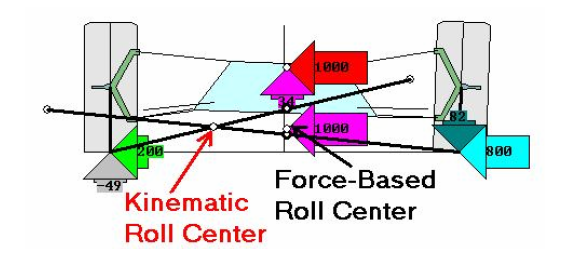
You can have zero jacking moments (geometric roll centres at ground level x whatever tyre thrust you throw at them), hence no geometric leverage but still have a large roll moment - in which case all weight transfer is via the springs.
Conversely, you can have no roll moment (geometric roll centre at CoG height), hence all weight transfer via the geometric roll centres, but still have substantial jacking effect.
Thank you for taking the time to explain that "The last post" (Any chance of a name? You seem a knowledgeable chap, and I'd hate to have to call you that forever more!) I think it is sinking in now.
So, in my own mind so far;
I am currently thinking only of the forces created by the roll centre and COG being at different heights. However, the force is generated at the tyre, and must be fed to the roll centre. This is therefore via the suspension system. It is this reaction to cornering force, due to any height differences, that you are referring to.
Far off?
That last diagram that you posted, how are you working out the force based roll centre height, exactly? As I see it lies just above the centre line crossing point in that example.
This is making me think of my thread that is just a few threads away from this one, if you would care to look (and comment if you would be so kind), regarding longer wishbones on a McPherson / Chapman Strut system. I would have thought that having a longer arm would give a less "snappy" transition past the dead spot. Perhaps a reason why single seater designers seem to prefer the longest arms practical?
I shall look up the book you referred to, too.
Oh, and my bad on the separate COG thing, I didn't actually mean that to read that way, but it does, and I look dumb!
- Mark
So, in my own mind so far;
I am currently thinking only of the forces created by the roll centre and COG being at different heights. However, the force is generated at the tyre, and must be fed to the roll centre. This is therefore via the suspension system. It is this reaction to cornering force, due to any height differences, that you are referring to.
Far off?
That last diagram that you posted, how are you working out the force based roll centre height, exactly? As I see it lies just above the centre line crossing point in that example.
This is making me think of my thread that is just a few threads away from this one, if you would care to look (and comment if you would be so kind), regarding longer wishbones on a McPherson / Chapman Strut system. I would have thought that having a longer arm would give a less "snappy" transition past the dead spot. Perhaps a reason why single seater designers seem to prefer the longest arms practical?
I shall look up the book you referred to, too.
Oh, and my bad on the separate COG thing, I didn't actually mean that to read that way, but it does, and I look dumb!
- Mark
Mark_r33 said:
That last diagram that you posted, how are you working out the force based roll centre height, exactly? As I see it lies just above the centre line crossing point in that example.
I should stress that the diagram is not my own - it was stolen from Bill Mitchell, via Google!The short answer is that it's very difficult: it depends on knowing the thrusts being generated at each tyre contact patch, so that you can work out the moments they generate in conjunction with the instantaneous centres of their suspension linkages.
To get close, you need to do a lot of mathematical modelling of the weight transfer, geometric leverages and tyre frictional coefficients, and it's questionable whether the accuracy of the results justifies the effort involved.
I've never done any work on MacPherson strut geometry so I don't consider myself qualified to offer an opinion, I'm afraid.
Designers of single seaters usually prefer longer arms for no more complicated a reason than they give less lateral deflection for a given vertical deflection, though, I think!
If the RC is on the floor, there is no jacking. Big roll moment. Lots of roll.
If it is at CG hieght, there is lots of jacking. No roll moment. No roll.
Do the 'no roll moment' and significant jacking then add together, to make the car lean into the corner?
This seems to be what you are suggesting. To my understanding however, the increased jacking as the RC rises is what is reducing the roll, not a separate entity.
My understanding on RCs is from Ortiz - http://www.shock-dyno.com/Ortiz/Ortiz-8-2004.pdf
Says a lot of what you have, about differing contributions from tyres, however reading between the lines it suggests as I understand it, jacking IS geometric anti roll. The same way longitudinal jacking IS anti-dive/anti squat.
If it is at CG hieght, there is lots of jacking. No roll moment. No roll.
Do the 'no roll moment' and significant jacking then add together, to make the car lean into the corner?
This seems to be what you are suggesting. To my understanding however, the increased jacking as the RC rises is what is reducing the roll, not a separate entity.
My understanding on RCs is from Ortiz - http://www.shock-dyno.com/Ortiz/Ortiz-8-2004.pdf
Says a lot of what you have, about differing contributions from tyres, however reading between the lines it suggests as I understand it, jacking IS geometric anti roll. The same way longitudinal jacking IS anti-dive/anti squat.
Edited by Kozy on Friday 22 March 10:08
Edited by Kozy on Friday 22 March 10:09
Kozy said:
...the increased jacking as the RC rises is what is reducing the roll, not a separate entity.
But you don't get jacking with a live axle, yet if you increase the height of the roll axis on a live axle car until it coincides with the CoG, you don't get any roll. Not even a smidgen. None. Nada. Zip.QED: jacking and roll moments are separate entities and can be treated as such.
I think the best thing I can suggest is that you re-read the simple example calculations I quoted from Costin and Phipps; if you're not understanding that the result of the final calculation is 100lb of net vertical thrust, then you're missing the point.
As I tried to explain previously, the roll moment and the jacking moments are couples between entirely different forces and distances.
focus on the bit where I said:
The roll moment is the couple of cornering force (acting on the CoG of the sprung mass) x distance between geometric roll axis and CoG.
The jacking moments are the couples of tyre thrust x distance between tyre contact patch and instantaneous centre
A picture might paint a thousand words (I've used swing axles suspension for simplicity, but double wishbone with each pair of wishbones giving an instantaneous centre works on the same principle) The ROLL COUPLE is shown in RED. The JACKING COUPLES are shown in GREEN. They are quite separate from each other:The jacking moments are the couples of tyre thrust x distance between tyre contact patch and instantaneous centre
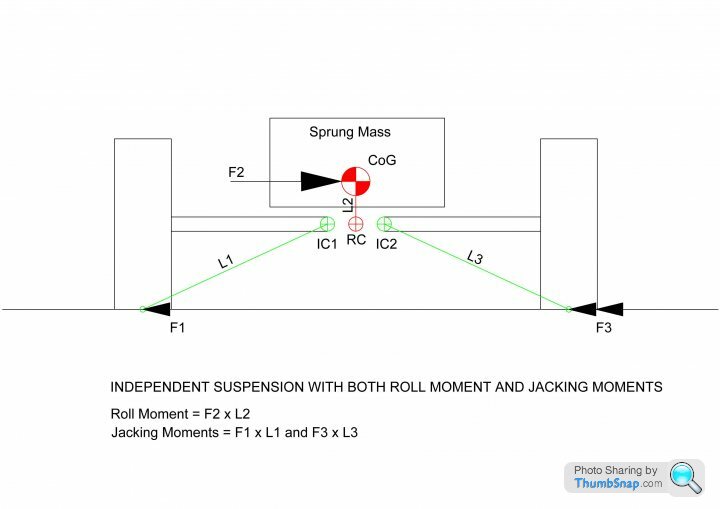
Note that because the outer tyre is more heavily loaded due to weight transfer, F1 and F2 are not of the same magnitude. It's this fact that results in a net jacking force... moment F3.L3 pushes the car up more than L1.F1 pulls it down.
I can kind of see where you're coming from in seeing them as the same force, though, because these sets of couples are effectively reacting against (or in conjunction with) each other...
Zen and the art of vehicle dynamics: both hands clapping.

- You could think of the roll moment as a (usually inverted) pendulum, with the sprung mass acting as the ‘bob’ weight and its pivot (the geometric roll centre) being restrained only via set of articulated linkages connecting it, via the tyres, to the ground:
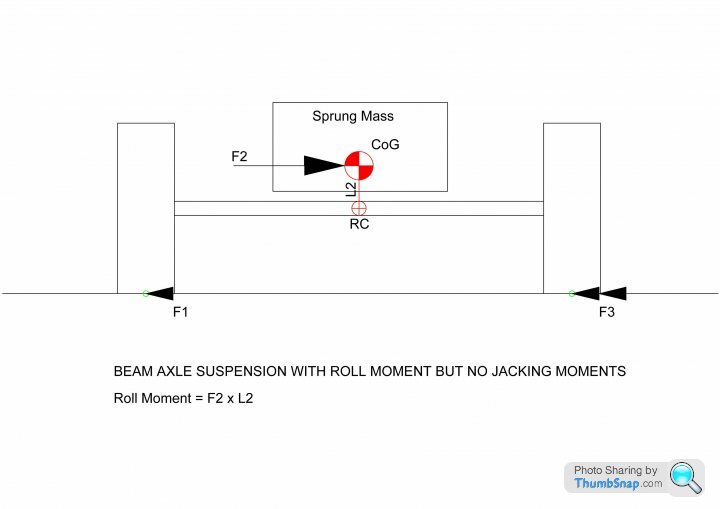
- Conversely, the jacking moments are pairs of articulated linkages acting as levers, reacting the tyre thrusts against the sprung mass, via the instant centres …and these pairs of leverages can be trying to rotate the sprung mass either into or against the bend, depending on the positions of the instant centres, whilst also (unless their neutral axis is actually at ground level) trying to jack it vertically up or down.
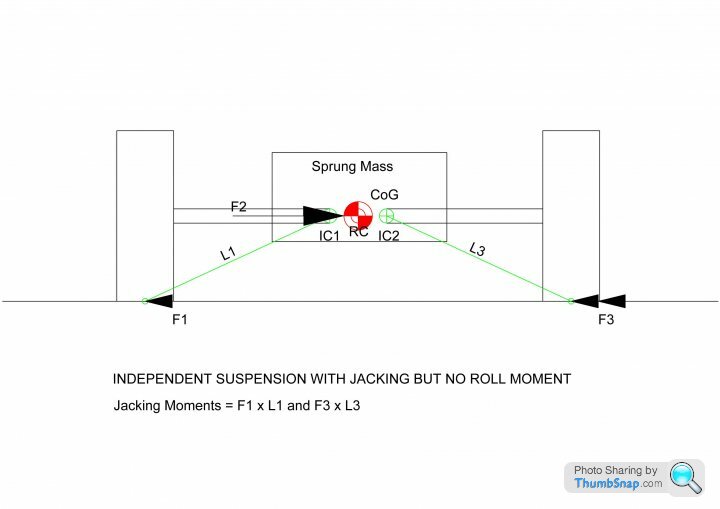
And note particularly that if you moved the instantaneous centres in the above diagram so that they coincided with the roll centre, on the centreline of the car, there would be no tendency for them to try to rotate the sprung mass at all: the net force would be pure jacking.
Move them further, so that they lie on the opposite sides of the car from the wheels they serve, and the tendency would be to try to rotate the car in the opposite direction.
Gassing Station | Suspension, Brakes & Tyres | Top of Page | What's New | My Stuff




